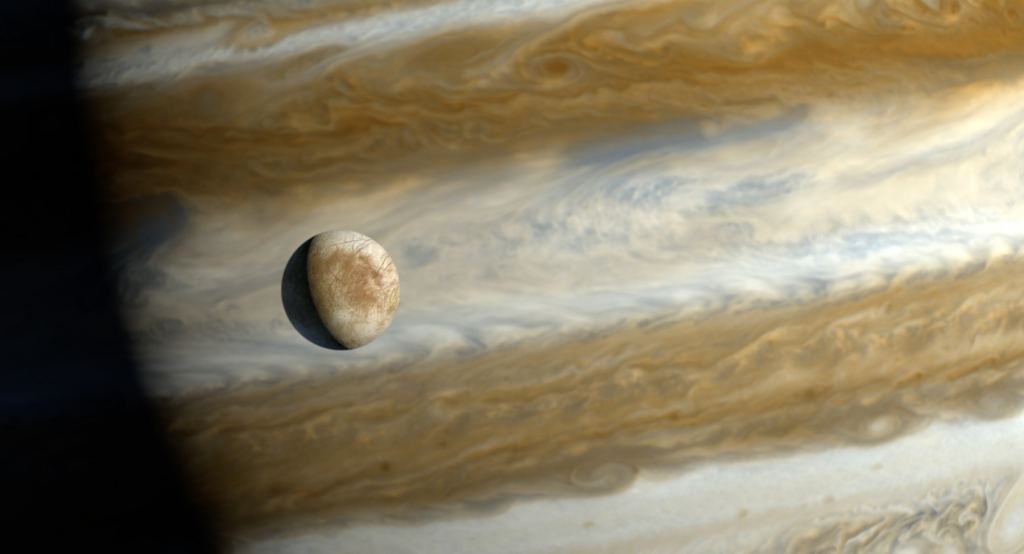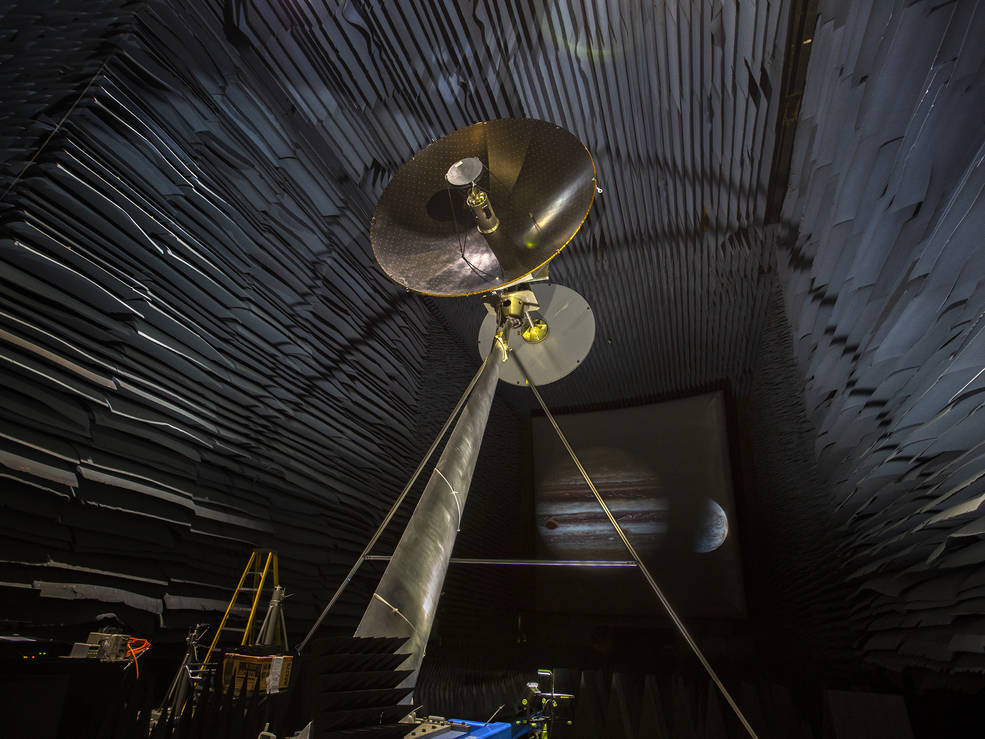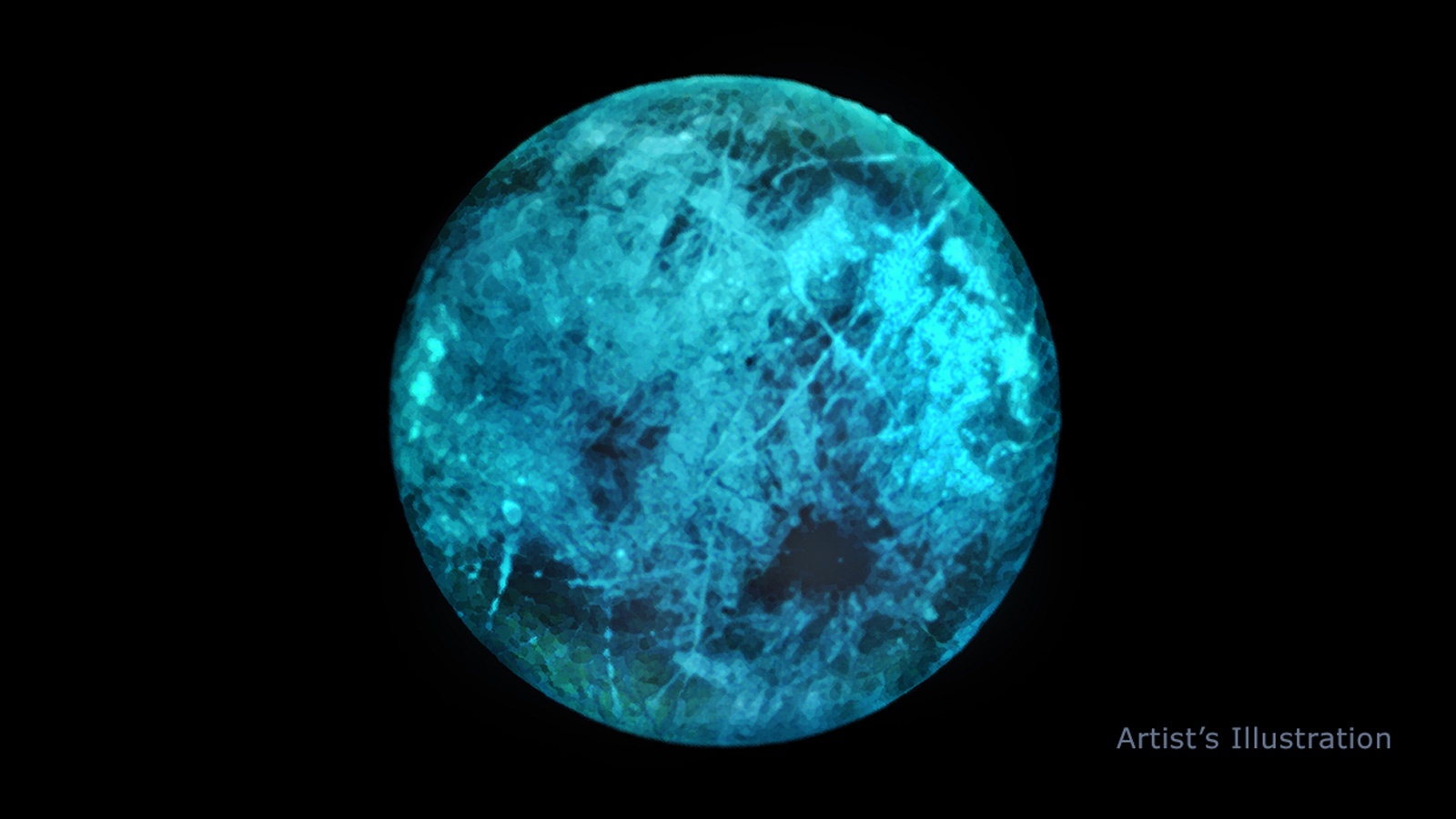In a few years, NASA will be sending a spacecraft to explore Jupiter’s icy moon Europa. Known as the Europa Clipper mission, this orbiter will examine the surface more closely to search for plume activity and evidence of biosignatures. Such a find could answer the burning question of whether or not there is life within this moon, which is something scientists have speculated about since the 1970s.
In anticipation of this mission, scientists continue to anticipate what it will find once it gets there. For instance, scientists from NASA’s Jet Propulsion Laboratory recently conducted a study that showed how Europa might glow in the dark. This could be the result of Europa constantly being pummeled with high-energy radiation from Jupiter’s magnetic field, the study of which could tell scientists more about the composition of Europa’s ice.
The study, titled “Laboratory predictions for the night-side surface ice glow of Europa“, recently appeared in the journal Nature Astronomy. The study was conducted by Murthy S. Gudipati and Bryana L. Henderson (two researchers with the JPL Science Division) and Fred B. Bateman of the National Institute of Standards and Technology (NIST) in Gaithersburg, Maryland.

As they indicate in their study, spectrometer readings of Europa have been made several times in the past in order to determine the composition of its ice. These readings have always been obtained by measuring the spectra of the light reflected from the moon’s dayside. However, a spacecraft orbiting the moon would be able to gather spectra from the night side and gather spectra directly.
Depending on the presence of different salty compounds, the surface would glow with a combination of unique glimmers. These would range in brightness and color – from slightly green to slightly blue or white – depending on what the material is. As Dr. Gudipati (the lead author on the study) explained in a NASA press release, the results he and his colleagues obtained provide a glimpse into what the Europa Clipper might see:
“We were able to predict that this nightside ice glow could provide additional information on Europa’s surface composition. How that composition varies could give us clues about whether Europa harbors conditions suitable for life.”
This is due to Europa’s interior ocean, which sometimes sends material to the surface through resurfacing events and plumes. In short, by analyzing the surface of Europa, scientists can learn more about what’s going on inside. In order to get a better idea of what direct observations might reveal, the JPL team built the Ice Chamber for Europa’s High-Energy Electron and Radiation Environment Testing (ICE-HEART).

This instrument was taken to the NIST’s Medical Industrial Radiation Facility where the team began conducting experiments to see how organic material under Europa’s ice sheet would react to blasts of radiation from a high-energy electron beam. As Henderson explained:
“But we never imagined that we would see what we ended up seeing. When we tried new ice compositions, the glow looked different. And we all just stared at it for a while and then said, ‘This is new, right? This is definitely a different glow?’ So we pointed a spectrometer at it, and each type of ice had a different spectrum.”
Co-author and NIST researcher Fred Bateman was responsible for subjecting the ice samples to bursts of high-energy electrons. What they found (serendipitously) were variations in the way the ice glowed, which was tied to different compositions. For instance, they were surprised to find that sodium chloride brines glowed with a significantly lower intensity than other salts.
This is what is particularly exciting about the team’s research, which is the way it anticipates how a moon like Europa can glow in the dark. As Gudipati said:
“If Europa weren’t under this radiation, it would look the way our moon looks to us – dark on the shadowed side. But because it’s bombarded by the radiation from Jupiter, it glows in the dark.
“It’s not often that you’re in a lab and say, ‘We might find this when we get there.’ Usually it’s the other way around – you go there and find something and try to explain it in the lab. But our prediction goes back to a simple observation, and that’s what science is about.”

Set to launch by the mid-2020s, the Europa Clipper will reach Jupiter and establish orbit around the gas giant by 2030 or 2031. In the course of its mission, it will make about 45 close passes of Europa, shiting its flight path with each flyby to soar over a different location. This will allow the orbiter to gather spectra and other data on almost the entire surface of the moon.
At the moment, mission scientists are reviewing this study to evaluate if a glow would be detectable by the spacecraft’s science instruments. The results obtained by the Europa Clipper could even be matched against the results of the JPL study to help identify or constrain the salty components identified on Europa’s surface.
These and other studies are part of the growing discipline of astrobiology, the interdisciplinary field concerned with life beyond Earth. In addition to gathering composition data and identifying possible biosignatures on Europa, the Europa Clipper could reveal how other icy moons with interior oceans – like Ganymede, Enceladus, Titan, and many more – could be the best bet for finding extraterrestrial life.
Understanding the habitability of these icy bodies will also help scientists unlock the mystery of howe life developed on Earth billions of years ago, not to mention how and where it might exist beyond the Solar System.
Further Reading: NASA, Nature Astronomy

